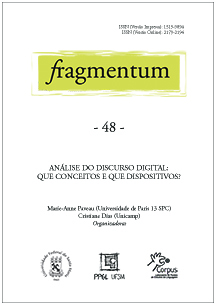ICONOTEXTUAL MEMETIC DEVICES: UNSTABLE CLICHES AND SUBVERSION OF GENRES
DOI:
https://doi.org/10.5902/fragmentum.v0i48.23294Keywords:
Digital discourse analysis, Memetics, Semiotics.Abstract
Advice Animal memes resort to the use of animals and humans embodying behavioral clichés, and whose discourse is reinforced by their titles (‘memonymes’) as well as the decontextualization of the initial image. Although these memes feature discourse belonging to specific genres (advice, personal stories, satire…), they challenge them: advice is ludicrous, and satire only recuperate others’ discourse and replace it in another context. Archetypes break the existing rules, whether animal or human stereotypes: animal clichés update through selfcontradiction, and social preconceptions are simultaneously summoned and dismantled.Downloads
References
AGAMBEM, Giorgio. Qu’est-ce qu’un dispositive? Rivages Poche. Petit Bibliothè, 2014.
BARTLETT, Jamie. The Dark Net. Random House, 2014.
CLARK, Sean. An Hero. The Troll Cave. Publié le 20 février 2011. Disponible à l’adresse: http://punk1119-thetrollcave.blogspot.fr/2011/02/hero.html. Dernier accès le: 14 juin 2016.
DAVIES, Mark. The Corpus of Contemporary American English: 520 million words, 1990-present. 2008. Disponible à l’adresse: http://corpus.byu.edu/coca/. Dernier accès le: 29 juin 2016.
GEACH, Peter. Ontological relativity and relative identity. In: MUNITZ, Milton K., Logic and Ontology. New York, New York University Press, 1973.
HUFFMAN, S.; OHANIAN, A. Reddit. 2005-. Disponible à l’adresse: www.reddit.com. Dernier accès le : 30 juin 2016.
JOUXTEL, Pascal. Les mèmes dans le dictionnaire Larousse, Société francophone de mémétique. Publié le 25 septembre 2015. Disponible à l’adresse: http://www.memetique.org/2013/09/les-memes-dans-le-larousse-2014/#more-1334. Dernier accès le: 10 juin 2016.
KIM, Brad (Ed.). Know your Meme. 2008-. Disponible à l’adresse: http://knowyourmeme.com/. Dernier accès le: 30 juin 2016.
MANDIBERG, Michael. The Social Media Reader. NYU Press, 2012.
PAVEAU, Marie-Anne. Les prédiscours. Sens, mémoire, cognition. Paris: Presses Sorbonne nouvelle, 2006.
POOLE, Christopher. 4Chan. 2003-. Disponible à l’adresse: www.4chan.org. Dernier accès le: 30 juin 2016.
RASTIC, A.; DAZDAREVIC, S.; FIJULJANIN, F. New language media: internet memes manuscripts. UNITE: v. 1, n. 2, p. 38–44. 2014.
SCHAAF, Alan. Imgur, 2009-. Disponible à l’adresse: www.imgur.com. Dernier accès le: 27 juin 2016.
SHIFMAN, Limor. Memes in Digital Culture. MIT Press, 2014.
VICKERY, Jacqueline. R. The curious case of Confession Bear: the reappropriation of online macro-image memes. Information, Communication & Society, v. 17, n. 3, p. 301325. 2014.
ZAPPAVIGNA, Michele. Searchable talk: The linguistic functions of hashtags. Social Semiotics, v. 25, n. 3, p. 274-291. 2015.
Downloads
Published
How to Cite
Issue
Section
License
Ficam concedidos a Fragmentum todos os direitos autorais referentes aos trabalhos publicados. Os originais não devem ter sido publicados ou submetidos simultaneamente a outro periódico e não serão devolvidos. Em virtude de aparecerem nesta revista de acesso público, os artigos são de uso gratuito, com atribuições próprias, em aplicações educacionais e não comerciais.



